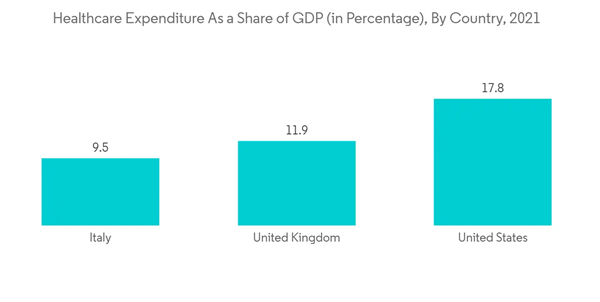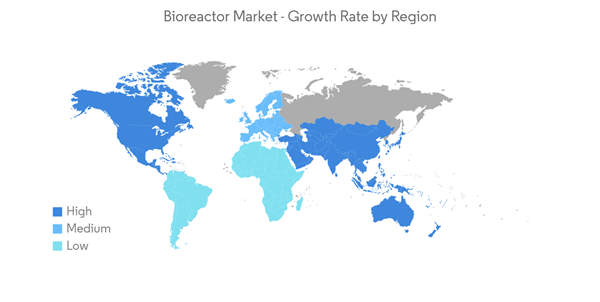Bioreactors have great potential uses in the development of vaccines and other pharmaceutical products that are being used to mitigate the spread of COVID-19 across the world. The high demand from governmental vaccination programs and private entities to vaccinate large sections of the population requires scientists to work under pressure to shorten the time-to-market of developed vaccines. This has created a huge demand for bioreactors from the biopharmaceutical and biotechnology industries during the early phase of the pandemic. According to an article published by the Frontiers in August 2022, bioreactors were widely used in cell culture-based viral vaccine production, especially during the COVID-19 pandemic, and the development and application of bioreactors provided more efficient and cost-effective vaccine production to meet the global vaccine demand. Thus, COVID-19 had a positive impact on the bioreactor market initially. However, currently, the market growth slowed down as the pandemic subsided, and it is expected to witness a stable growth during the forecast period of the study.
The growth of bioreactors in pharmaceuticals, technological advancements in bioreactors, and adoption of single-use bioreactors (SUBs) and hybrid bioreactors are the prime factors responsible for the growth of the bioreactor market currently.
Biopharmaceuticals are utilized in a range of applications, from being in the production of biopharmaceuticals to applications in tissue engineering, such as cell expansion and generation of 3D tissue constructs. Bioreactors are, thus, used in providing a controllable environment, in terms of pH, temperature, nutrient supply, and shear stress for any cells or cellular constructs incorporated into them. For instance, according to an article published by the PubMed Central in February 2022, bioreactors allow production to be increased to industrial scales, which can quickly and cheaply produce large amounts of secondary metabolites and recombinant proteins in a short time. Bioreactors have been utilized in many different areas of industry and research and for the progression of in vitro models of 2D cultures and suspensions to 3D constructs, mimicking the natural physiological state in situ. They have also proven to be crucial medicines that are used in autoimmune disorders, cancer, asthma, and organ rejection. Thus, the growth of bioreactors in the pharmaceutical sector is the major factor augmenting the growth of the market.
Furthermore, the technological advancements in bioreactors have improved the flexibility, quality, and scalability of operations with low capital and energy requirements. The innovative methods and the analytical tools are projected to enhance the process robustness, accelerate scale-up to industrial production, and drive the efficient use of resources. The extensive use of hybrid bioreactor technology in effective waste management has also further accelerated the expansion of the market.
Initiatives by major companies are also boosting the market growth. For instance, in May 2021, Beckman Coulter Life Sciences launched its next-generation Biolector XT Microbioreactor in Germany. The BioLector XT Microbioreactor allows cultivation parameter monitoring, high-throughput strain screenings, and feeding strategy optimization.
Thus, owing to the benefits offered by the bioreactor technology and its increasing application in different areas, the studied market is expected to witness significant growth over the forecast period. However, concerns regarding the use of single-use bioreactors and limited storage capacity can hamper the market growth.
Bioreactors Market Trends
The Single-use Bioreactors Segment is Expected to Have A High Growth Rate During the Forecast Period
- Single-use bioreactors (SUB) from the material type segmentation are expected to have a high growth rate during the forecast period of the study. Recently, single-use bioreactors have been increasingly adopted in modern biopharmaceutical processes. This is primarily due to their unique ability to enhance flexibility, reduce investment, and limit operational costs.
- Owing to the high adoption rate and the increasing preference for deploying SUBs, the market players are continuously focusing on product launches and innovations. For instance, in February 2021, WuXi Biologics's MFG5 Drug Substance (DS) manufacturing facility in China successfully launched a GMP operation with a capacity of 36,000L, deploying nine 4,000L single-use bioreactors. As a major landmark in the company's global capacity planning, the GMP launch of MFG5 brings WuXi Biologics' current capacity to 90,000L, greatly enhancing the capability to enable global partners.
- Also, in June 2022, ABEC announced that mAbxience will equip their state-of-the-art cGMP facility in León, Spain with an additional ABEC 4,000L single-use custom single-run (CSR) bioreactor. Therefore, due to the above-mentioned factors, the segment is expected to witness growth.
North America Holds a Significant Market Share Currently, which is Expected to Continue Over the Forecast Period
- North America currently holds a significant share of the market for bioreactors, and it is expected to continue its stronghold for a few more years. This region is expected to increase its market share in the future, owing to the rise in collaboration among the industry and academic institutions. The United States holds the majority of the market in the North American region because pharmaceuticals and hi-tech product makers have announced multimillion-dollar investments to expand manufacturing capabilities.
- Additionally, the United States and Canada, two of the largest countries in this region, spend a lot on research and development expenses. For instance, according to the data published by NIH in May 2022, the United States spent around USD 7,847 million in biotechnology research in 2021, and it is expected to reach USD 8,142 million in 2022. The high amount being spent is expected to boost market growth since it translates to greater demand for new drugs and pharmaceutical ingredients that are manufactured by bioreactors.
- Various strategies, such as research and development, mergers and acquisitions, and product launches, are being adopted by domestic companies to strengthen their market position. For instance, in March 2021, Thermo Fisher Scientific launched its HyPerforma DynaDrive 3,000 L and HyPerforma DynaDrive 5,000 L single-use bioreactors due to strong demand for large-scale single-use systems. Product launches, such as these, are expected to boost the market growth during the forecast period.
- Also, the growing demand for biopharmaceutical products in the region and the focus on increasing localized production are expected to have a positive impact on the market over the forecast period.
Bioreactors Industry Overview
The bioreactor market is moderately fragmented and consists of several major players. In terms of market share, a few of the major players currently dominate the market. However, with technological advancements and product innovations, mid-size to smaller companies are increasing their market presence by introducing new products at lower prices. Companies, like Sartorius AG, Thermo Fisher Scientific Inc., Pall Corporation (Danaher Corporation), and Eppendorf AG, hold a significant market share in the bioreactor market.Additional Benefits:
- The market estimate (ME) sheet in Excel format
- 3 months of analyst support
This product will be delivered within 2 business days.
Table of Contents
Companies Mentioned (Partial List)
A selection of companies mentioned in this report includes, but is not limited to:
- GE Healthcare
- Merck KGaA
- Eppendorf AG
- Sartorius AG
- Pall Corporation (Danaher Corporation)
- Getinge AB
- Bioengineering AG
- Infors HT
- Solida Biotech GmBH
- Solaris Biotech
- Thermo Fisher Scientific Inc.
- Esco Lifesciences Group Ltd










